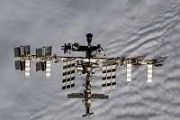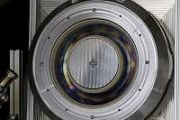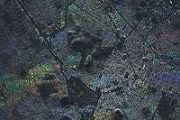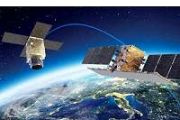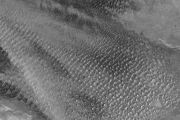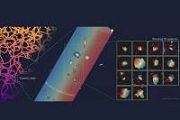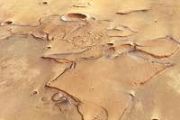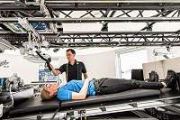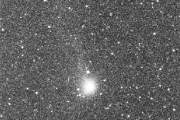
Copernical Team
A growing baby planet photographed for first time in a ring of darkness
 A team of astronomers has detected for the first time a growing planet outside our solar system, embedded in a cleared gap of a multi-ringed disk of dust and gas.
The team, led by University of Arizona astronomer Laird Close and Richelle van Capelleveen, an astronomy graduate student at Leiden Observatory in the Netherlands, discovered the unique exoplanet using the University of Arizona's
A team of astronomers has detected for the first time a growing planet outside our solar system, embedded in a cleared gap of a multi-ringed disk of dust and gas.
The team, led by University of Arizona astronomer Laird Close and Richelle van Capelleveen, an astronomy graduate student at Leiden Observatory in the Netherlands, discovered the unique exoplanet using the University of Arizona's Mars mantle holds fragments from ancient giant impacts study finds
 Rocky material buried deep within Mars has been traced to colossal impacts 4.5 billion years ago, according to new findings from NASA's retired InSight lander. The discovery points to lumps of mantle rock, some up to 2.5 miles (4 kilometers) wide, scattered beneath the surface.
Scientists believe massive collisions melted large portions of early Mars into magma oceans while forcing fragmen
Rocky material buried deep within Mars has been traced to colossal impacts 4.5 billion years ago, according to new findings from NASA's retired InSight lander. The discovery points to lumps of mantle rock, some up to 2.5 miles (4 kilometers) wide, scattered beneath the surface.
Scientists believe massive collisions melted large portions of early Mars into magma oceans while forcing fragmen Surprising carbon dioxide rich disk challenges planet theory
 A team led by Stockholm University has identified a young star surrounded by a disk unusually dominated by carbon dioxide, defying current theories of planet formation. Using the James Webb Space Telescope's MIRI instrument, the researchers found that water vapor is nearly absent in the disk, while carbon dioxide shows up strongly in regions where rocky planets could eventually take shape.
A team led by Stockholm University has identified a young star surrounded by a disk unusually dominated by carbon dioxide, defying current theories of planet formation. Using the James Webb Space Telescope's MIRI instrument, the researchers found that water vapor is nearly absent in the disk, while carbon dioxide shows up strongly in regions where rocky planets could eventually take shape. Solar Orbiter traces superfast electrons back to Sun
 The European Space Agency-led Solar Orbiter mission has split the flood of energetic particles flung out into space from the Sun into two groups, tracing each back to a different kind of outburst from our star.
The Sun is the most energetic particle accelerator in the Solar System. It whips up electrons to nearly the speed of light and flings them out into space, flooding the Solar System
The European Space Agency-led Solar Orbiter mission has split the flood of energetic particles flung out into space from the Sun into two groups, tracing each back to a different kind of outburst from our star.
The Sun is the most energetic particle accelerator in the Solar System. It whips up electrons to nearly the speed of light and flings them out into space, flooding the Solar System Clues from Butterfly Nebula dust advance knowledge of rocky planet origins
 Clues about the formation of Earth-like planets have emerged from the Butterfly Nebula NGC 6302, where astronomers used the James Webb Space Telescope and ALMA to probe its dusty heart. The combined observations revealed crystalline silicates, irregular dust grains, jets of iron and nickel, and even carbon-based molecules thought to be precursors of life.
Lead researcher Dr Mikako Matsuura
Clues about the formation of Earth-like planets have emerged from the Butterfly Nebula NGC 6302, where astronomers used the James Webb Space Telescope and ALMA to probe its dusty heart. The combined observations revealed crystalline silicates, irregular dust grains, jets of iron and nickel, and even carbon-based molecules thought to be precursors of life.
Lead researcher Dr Mikako Matsuura Britain's energy grid bets on flywheels to keep the lights on
 Britain's energy operator is betting on an age-old technology to future-proof its grid, as the power plants that traditionally helped stabilise it are closed and replaced by renewable energy systems.
Spinning metal devices known as flywheels have for centuries been used to provide inertia - resistance to sudden changes in motion - to various machines, from a potter's wheel to the steam eng
Britain's energy operator is betting on an age-old technology to future-proof its grid, as the power plants that traditionally helped stabilise it are closed and replaced by renewable energy systems.
Spinning metal devices known as flywheels have for centuries been used to provide inertia - resistance to sudden changes in motion - to various machines, from a potter's wheel to the steam eng AI systems developed to improve fusion reactor safety and performance
 A research team led by Prof. Sun Youwen at the Hefei Institutes of Physical Science of the Chinese Academy of Sciences has unveiled two artificial intelligence systems designed to enhance the stability and efficiency of fusion experiments. Their results appear in the journals Nuclear Fusion and Plasma Physics and Controlled Fusion.
Fusion energy promises clean, virtually inexhaustible powe
A research team led by Prof. Sun Youwen at the Hefei Institutes of Physical Science of the Chinese Academy of Sciences has unveiled two artificial intelligence systems designed to enhance the stability and efficiency of fusion experiments. Their results appear in the journals Nuclear Fusion and Plasma Physics and Controlled Fusion.
Fusion energy promises clean, virtually inexhaustible powe Circle versus rectangle: Finding 'Earth 2.0' may be easier using a new telescope shape
 The Earth supports the only known life in the universe, all of it depending heavily on the presence of liquid water to facilitate chemical reactions. While single-celled life has existed almost as long as the Earth itself, it took roughly three billion years for multicellular life to form. Human life has existed for less than one 10 thousandth of the age of the Earth.
All of this suggests
The Earth supports the only known life in the universe, all of it depending heavily on the presence of liquid water to facilitate chemical reactions. While single-celled life has existed almost as long as the Earth itself, it took roughly three billion years for multicellular life to form. Human life has existed for less than one 10 thousandth of the age of the Earth.
All of this suggests Earth's chemistry settled early but later collision likely delivered water for life
 Earths chemical make-up reached completion within the first three million years of the Solar Systems formation, according to a new study by the University of Berns Institute of Geological Sciences. However, this early Earth, known as the proto-Earth, lacked volatile elements such as water and carbon compounds that are essential for life.
The findings, published in Science Advances, suggest
Earths chemical make-up reached completion within the first three million years of the Solar Systems formation, according to a new study by the University of Berns Institute of Geological Sciences. However, this early Earth, known as the proto-Earth, lacked volatile elements such as water and carbon compounds that are essential for life.
The findings, published in Science Advances, suggest Elbit Systems JUPITER camera deployed on NAOS satellite with OHB Italia partnership
 Elbit Systems has confirmed the successful launch of its JUPITER space camera aboard the National Advanced Optical System (NAOS) satellite, built by OHB Italia. The spacecraft lifted off from Vandenberg Space Force Base in California on a SpaceX Falcon 9, beginning its role in diverse Earth observation missions.
Developed by Elbit Systems ISTAR and EW - ELOP, JUPITER is described as one of
Elbit Systems has confirmed the successful launch of its JUPITER space camera aboard the National Advanced Optical System (NAOS) satellite, built by OHB Italia. The spacecraft lifted off from Vandenberg Space Force Base in California on a SpaceX Falcon 9, beginning its role in diverse Earth observation missions.
Developed by Elbit Systems ISTAR and EW - ELOP, JUPITER is described as one of 






